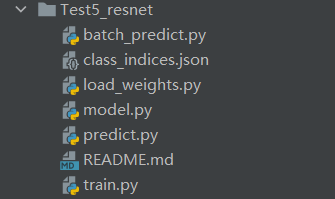
model.py
import torch.nn as nn
import torch#首先定义34层残差结构
class BasicBlock(nn.Module):expansion = 1 #对应主分支中卷积核的个数有没有发生变化#定义初始化函数(输入特征矩阵的深度,输出特征矩阵的深度(主分支上卷积核的个数),不惧默认设置为1,下采样参数设置为None)def __init__(self, in_channel, out_channel, stride=1, downsample=None, **kwargs):super(BasicBlock, self).__init__()self.conv1 = nn.Conv2d(in_channels=in_channel, out_channels=out_channel,kernel_size=3, stride=stride, padding=1, bias=False)self.bn1 = nn.BatchNorm2d(out_channel)self.relu = nn.ReLU()self.conv2 = nn.Conv2d(in_channels=out_channel, out_channels=out_channel,kernel_size=3, stride=1, padding=1, bias=False)self.bn2 = nn.BatchNorm2d(out_channel)self.downsample = downsample#定义正向传播的过程def forward(self, x):identity = xif self.downsample is not None:identity = self.downsample(x) #将输入传入下采样函数得到捷径分支的输出#主分支上的输出out = self.conv1(x)out = self.bn1(out)out = self.relu(out)out = self.conv2(out)out = self.bn2(out)out += identity #将主分支上的输出加上捷径分支上的输出out = self.relu(out)return out #得到残差结构的最终输出#定义50层、101层、152层的残差结构,在这个网络上进行修改得到ResNext网络
class Bottleneck(nn.Module):"""注意:原论文中,在虚线残差结构的主分支上,第一个1x1卷积层的步距是2,第二个3x3卷积层步距是1。但在pytorch官方实现过程中是第一个1x1卷积层的步距是1,第二个3x3卷积层步距是2,这么做的好处是能够在top1上提升大概0.5%的准确率。可参考Resnet v1.5 https://ngc.nvidia.com/catalog/model-scripts/nvidia:resnet_50_v1_5_for_pytorch"""expansion = 4 #残差结构所使用卷积核的一个变化#定义初始化函数def __init__(self, in_channel, out_channel, stride=1, downsample=None,#相比resnet网络多传入了两个参数groups=1, width_per_group=64,groups=1, width_per_group=64):super(Bottleneck, self).__init__()width = int(out_channel * (width_per_group / 64.)) * groupsself.conv1 = nn.Conv2d(in_channels=in_channel, out_channels=width,kernel_size=1, stride=1, bias=False) # squeeze channelsself.bn1 = nn.BatchNorm2d(width)# -----------------------------------------#输入、输出特征矩阵的channel设置为widthself.conv2 = nn.Conv2d(in_channels=width, out_channels=width, groups=groups,kernel_size=3, stride=stride, bias=False, padding=1)self.bn2 = nn.BatchNorm2d(width)# -----------------------------------------self.conv3 = nn.Conv2d(in_channels=width, out_channels=out_channel*self.expansion,kernel_size=1, stride=1, bias=False) # unsqueeze channelsself.bn3 = nn.BatchNorm2d(out_channel*self.expansion)self.relu = nn.ReLU(inplace=True)self.downsample = downsample#定义正向传播过程def forward(self, x):identity = xif self.downsample is not None:identity = self.downsample(x)out = self.conv1(x)out = self.bn1(out)out = self.relu(out)out = self.conv2(out)out = self.bn2(out)out = self.relu(out)out = self.conv3(out)out = self.bn3(out)out += identityout = self.relu(out)return out#定义ResNet网络模型
class ResNet(nn.Module):def __init__(self,block,#对应的就是残差结构blocks_num, #所使用残差结构的数目num_classes=1000, #训练集的分类个数include_top=True,#是为了在ResNet网络上搭建更复杂的网络groups=1,width_per_group=64):super(ResNet, self).__init__()self.include_top = include_top #传入类变量之中self.in_channel = 64 #输入特征矩阵的深度self.groups = groupsself.width_per_group = width_per_group#定义第一层的卷积层,3表示输入矩阵的深度self.conv1 = nn.Conv2d(3, self.in_channel, kernel_size=7, stride=2,padding=3, bias=False)self.bn1 = nn.BatchNorm2d(self.in_channel)self.relu = nn.ReLU(inplace=True)self.maxpool = nn.MaxPool2d(kernel_size=3, stride=2, padding=1) #最大池化下采样操作self.layer1 = self._make_layer(block, 64, blocks_num[0]) #一系列残差结构self.layer2 = self._make_layer(block, 128, blocks_num[1], stride=2)self.layer3 = self._make_layer(block, 256, blocks_num[2], stride=2)self.layer4 = self._make_layer(block, 512, blocks_num[3], stride=2)if self.include_top:self.avgpool = nn.AdaptiveAvgPool2d((1, 1)) # 自适应的平均池化下采样output size = (1, 1)self.fc = nn.Linear(512 * block.expansion, num_classes) #全连接层for m in self.modules():if isinstance(m, nn.Conv2d):nn.init.kaiming_normal_(m.weight, mode='fan_out', nonlinearity='relu')#(哪一个残差结构,残差结构中第一卷积层所使用卷积核的个数,该层包含了几个残差结构,步距为1)def _make_layer(self, block, channel, block_num, stride=1):downsample = None #定义下采样if stride != 1 or self.in_channel != channel * block.expansion: #对于十八层和三十四层的残差结构,就会跳过if语句;downsample = nn.Sequential( #生成下采样函数nn.Conv2d(self.in_channel, channel * block.expansion, kernel_size=1, stride=stride, bias=False),nn.BatchNorm2d(channel * block.expansion))layers = [] #定义空的列表#将第一层的残差结构传进去layers.append(block(self.in_channel,channel,downsample=downsample,stride=stride,groups=self.groups,width_per_group=self.width_per_group))self.in_channel = channel * block.expansion#实现实线部分for _ in range(1, block_num): #表示从一开始遍历,不写则默认是0层开始layers.append(block(self.in_channel,channel,groups=self.groups,width_per_group=self.width_per_group))return nn.Sequential(*layers) #非关键字参数的方式传入nn.squential函数#进行正向传播过程def forward(self, x):x = self.conv1(x)x = self.bn1(x)x = self.relu(x)x = self.maxpool(x)x = self.layer1(x)x = self.layer2(x)x = self.layer3(x)x = self.layer4(x)if self.include_top:x = self.avgpool(x)x = torch.flatten(x, 1)x = self.fc(x)return x#对网络进行实例化,传入BasicBlock或者Bottleneck来确定是哪个网络,第二个参数是block的个数
def resnet34(num_classes=1000, include_top=True):# https://download.pytorch.org/models/resnet34-333f7ec4.pthreturn ResNet(BasicBlock, [3, 4, 6, 3], num_classes=num_classes, include_top=include_top)def resnet50(num_classes=1000, include_top=True):# https://download.pytorch.org/models/resnet50-19c8e357.pthreturn ResNet(Bottleneck, [3, 4, 6, 3], num_classes=num_classes, include_top=include_top)def resnet101(num_classes=1000, include_top=True):# https://download.pytorch.org/models/resnet101-5d3b4d8f.pthreturn ResNet(Bottleneck, [3, 4, 23, 3], num_classes=num_classes, include_top=include_top)#进行升级ResNext网络
def resnext50_32x4d(num_classes=1000, include_top=True):# https://download.pytorch.org/models/resnext50_32x4d-7cdf4587.pthgroups = 32width_per_group = 4return ResNet(Bottleneck, [3, 4, 6, 3],num_classes=num_classes,include_top=include_top,groups=groups,width_per_group=width_per_group)def resnext101_32x8d(num_classes=1000, include_top=True):# https://download.pytorch.org/models/resnext101_32x8d-8ba56ff5.pthgroups = 32width_per_group = 8return ResNet(Bottleneck, [3, 4, 23, 3],num_classes=num_classes,include_top=include_top,groups=groups,width_per_group=width_per_group)
train.py
import os
import sys
import jsonimport torch
import torch.nn as nn
import torch.optim as optim
from torchvision import transforms, datasets
from tqdm import tqdm
from model import resnet34 #要进行训练的话,要导入需要的网络,是resnet34还是rtesnet50或者其他网络def main():device = torch.device("cuda:0" if torch.cuda.is_available() else "cpu")print("using {} device.".format(device))data_transform = {"train": transforms.Compose([transforms.RandomResizedCrop(224),transforms.RandomHorizontalFlip(),transforms.ToTensor(),transforms.Normalize([0.485, 0.456, 0.406], [0.229, 0.224, 0.225])]),#进行标准化的方法的参数是参考官网"val": transforms.Compose([transforms.Resize(256),#先通过resize将最小遍缩放到256,transforms.CenterCrop(224),#在使用中心裁剪transforms.ToTensor(),transforms.Normalize([0.485, 0.456, 0.406], [0.229, 0.224, 0.225])])}data_root = os.path.abspath(os.path.join(os.getcwd(), "../..")) # get data root pathimage_path = os.path.join(data_root, "data_set", "flower_data") # flower data set pathassert os.path.exists(image_path), "{} path does not exist.".format(image_path)train_dataset = datasets.ImageFolder(root=os.path.join(image_path, "train"),transform=data_transform["train"])train_num = len(train_dataset)# {'daisy':0, 'dandelion':1, 'roses':2, 'sunflower':3, 'tulips':4}flower_list = train_dataset.class_to_idxcla_dict = dict((val, key) for key, val in flower_list.items())# write dict into json filejson_str = json.dumps(cla_dict, indent=4)with open('class_indices.json', 'w') as json_file:json_file.write(json_str)batch_size = 16nw = min([os.cpu_count(), batch_size if batch_size > 1 else 0, 8]) # number of workersprint('Using {} dataloader workers every process'.format(nw))train_loader = torch.utils.data.DataLoader(train_dataset,batch_size=batch_size, shuffle=True,num_workers=nw)validate_dataset = datasets.ImageFolder(root=os.path.join(image_path, "val"),transform=data_transform["val"])val_num = len(validate_dataset)validate_loader = torch.utils.data.DataLoader(validate_dataset,batch_size=batch_size, shuffle=False,num_workers=nw)print("using {} images for training, {} images for validation.".format(train_num,val_num))#使用迁移学习的方法,所以需要使用Pytorch官方所提供的resnet网络的预训练模型,需要去下载net = resnet34() #需要用哪个网络就实例化哪个网络# load pretrain weights# download url: https://download.pytorch.org/models/resnet34-333f7ec4.pthmodel_weight_path = "./resnet34-pre.pth" #使用哪个权重就写哪个assert os.path.exists(model_weight_path), "file {} does not exist.".format(model_weight_path)net.load_state_dict(torch.load(model_weight_path, map_location='cpu'))# for param in net.parameters():# param.requires_grad = False#载入预训练模型的方法# change fc layer structurein_channel = net.fc.in_featuresnet.fc = nn.Linear(in_channel, 5) #将最后一个新连接层,替换成自己的新建的一个全连接层,5表示要分类的类别个数net.to(device)# define loss functionloss_function = nn.CrossEntropyLoss()# construct an optimizerparams = [p for p in net.parameters() if p.requires_grad]optimizer = optim.Adam(params, lr=0.0001)epochs = 3best_acc = 0.0save_path = './resNet34.pth' #保存权重的名字也进行相应的修改train_steps = len(train_loader)for epoch in range(epochs):# trainnet.train()#重要的running_loss = 0.0train_bar = tqdm(train_loader, file=sys.stdout)for step, data in enumerate(train_bar):images, labels = dataoptimizer.zero_grad()logits = net(images.to(device))loss = loss_function(logits, labels.to(device))loss.backward()optimizer.step()# print statisticsrunning_loss += loss.item()train_bar.desc = "train epoch[{}/{}] loss:{:.3f}".format(epoch + 1,epochs,loss)# validatenet.eval()acc = 0.0 # accumulate accurate number / epochwith torch.no_grad():val_bar = tqdm(validate_loader, file=sys.stdout)for val_data in val_bar:val_images, val_labels = val_dataoutputs = net(val_images.to(device))# loss = loss_function(outputs, test_labels)predict_y = torch.max(outputs, dim=1)[1]acc += torch.eq(predict_y, val_labels.to(device)).sum().item()val_bar.desc = "valid epoch[{}/{}]".format(epoch + 1,epochs)val_accurate = acc / val_numprint('[epoch %d] train_loss: %.3f val_accuracy: %.3f' %(epoch + 1, running_loss / train_steps, val_accurate))if val_accurate > best_acc:best_acc = val_accuratetorch.save(net.state_dict(), save_path)print('Finished Training')if __name__ == '__main__':main()
predict.py
import os
import jsonimport torch
from PIL import Image
from torchvision import transforms
import matplotlib.pyplot as pltfrom model import resnet34def main():device = torch.device("cuda:0" if torch.cuda.is_available() else "cpu")data_transform = transforms.Compose([transforms.Resize(256),transforms.CenterCrop(224),transforms.ToTensor(),transforms.Normalize([0.485, 0.456, 0.406], [0.229, 0.224, 0.225])])# load imageimg_path = "../tulip.jpg"assert os.path.exists(img_path), "file: '{}' dose not exist.".format(img_path)img = Image.open(img_path)plt.imshow(img)# [N, C, H, W]img = data_transform(img)# expand batch dimensionimg = torch.unsqueeze(img, dim=0)# read class_indictjson_path = './class_indices.json'assert os.path.exists(json_path), "file: '{}' dose not exist.".format(json_path)with open(json_path, "r") as f:class_indict = json.load(f)# create model 使用哪个网络就传入哪个网络model = resnet34(num_classes=5).to(device)# load model weightsweights_path = "./resNet34.pth" #权重进行相应的改变assert os.path.exists(weights_path), "file: '{}' dose not exist.".format(weights_path)model.load_state_dict(torch.load(weights_path, map_location=device))# predictionmodel.eval()with torch.no_grad():#不对损失梯度进行跟踪# predict classoutput = torch.squeeze(model(img.to(device))).cpu()predict = torch.softmax(output, dim=0)predict_cla = torch.argmax(predict).numpy() #最大值对相应的索引print_res = "class: {} prob: {:.3}".format(class_indict[str(predict_cla)],predict[predict_cla].numpy())plt.title(print_res)for i in range(len(predict)):print("class: {:10} prob: {:.3}".format(class_indict[str(i)],predict[i].numpy()))plt.show()if __name__ == '__main__':main()
batch_predict.py
#批量进行预测
import os
import jsonimport torch
from PIL import Image
from torchvision import transformsfrom model import resnet34def main():device = torch.device("cuda:0" if torch.cuda.is_available() else "cpu")data_transform = transforms.Compose([transforms.Resize(256),transforms.CenterCrop(224),transforms.ToTensor(),transforms.Normalize([0.485, 0.456, 0.406], [0.229, 0.224, 0.225])])# load image# 指向需要遍历预测的图像文件夹imgs_root = "/data/imgs"assert os.path.exists(imgs_root), f"file: '{imgs_root}' dose not exist."# 读取指定文件夹下所有jpg图像路径img_path_list = [os.path.join(imgs_root, i) for i in os.listdir(imgs_root) if i.endswith(".jpg")]# read class_indictjson_path = './class_indices.json'assert os.path.exists(json_path), f"file: '{json_path}' dose not exist."json_file = open(json_path, "r")class_indict = json.load(json_file)# create modelmodel = resnet34(num_classes=5).to(device)# load model weightsweights_path = "./resNet34.pth"assert os.path.exists(weights_path), f"file: '{weights_path}' dose not exist."model.load_state_dict(torch.load(weights_path, map_location=device))# predictionmodel.eval()batch_size = 8 # 每次预测时将多少张图片打包成一个batchwith torch.no_grad():for ids in range(0, len(img_path_list) // batch_size):img_list = []for img_path in img_path_list[ids * batch_size: (ids + 1) * batch_size]:assert os.path.exists(img_path), f"file: '{img_path}' dose not exist."img = Image.open(img_path)img = data_transform(img)img_list.append(img)# batch img# 将img_list列表中的所有图像打包成一个batchbatch_img = torch.stack(img_list, dim=0)# predict classoutput = model(batch_img.to(device)).cpu()predict = torch.softmax(output, dim=1)probs, classes = torch.max(predict, dim=1)for idx, (pro, cla) in enumerate(zip(probs, classes)):print("image: {} class: {} prob: {:.3}".format(img_path_list[ids * batch_size + idx],class_indict[str(cla.numpy())],pro.numpy()))if __name__ == '__main__':main()

 京公网安备 11010802041100号 | 京ICP备19059560号-4 | PHP1.CN 第一PHP社区 版权所有
京公网安备 11010802041100号 | 京ICP备19059560号-4 | PHP1.CN 第一PHP社区 版权所有